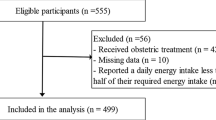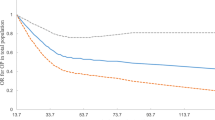Abstract
Sulfotransferase 1E1 (SULT1E1) catalyze estrogen into sulfate conjugation and is involved in the metabolism of phytoestrogen. A community-based cross-sectional study was conducted on 397 Korean women, to evaluate the association between genetic polymorphisms of SULT1E1 and bone mineral density (BMD) and the combined effect of the genetic polymorphism and phytoestrogen intake for BMD in Korean women. BMDs of the distal radius and the calcaneus were measured by dual-energy X-ray absorptiometry. Genotypes of SULT1E1 IVS1-447 C>A, IVS4-1653 T>C, and *959 G>A were determined by the 5′-nuclease assay (TaqMan). Phytoestrogen intake was estimated by a food-frequency questionnaire validated against multiple 24-hour recalls. Women with the SULT1E1 *959 GG genotype had a 4.5% lower BMD at the distal radius (P trend = 0.05) and a 7.9% lower BMD at the calcaneus compared to those with AA genotype (P trend < 0.01), whereas the SULT1E1 IVS1-447 CC genotype and IVS4-1653 TT genotype were not associated with BMD. There was no significant trend of BMD with the numbers of CTG-containing haplotypes, but calcaneal BMDs significantly differed between SULT1E1 CTA-CTA haplotype and CTG-CCA haplotype (P < 0.05). When stratified by SULT1E1 genotype, the correlation between phytoestrogen consumption and BMD at the calcaneus was noteworthy in women with SULT1E1 *959 GG genotype (r = 0.25, P = 0.01) or SULT1E1 IVS 4-1653 TT genotype (r = 0.15, P = 0.02). This trend remained significant only in postmenopausal women (r = 0.36, P = 0.01) after multiple testing was corrected by the false discovery rate method. In conclusion, the genetic polymorphism of SULT1E1 *959 G > A was associated with BMD at the distal radius and calcaneus, and the association between phytoestrogen consumption and calcaneal BMD might be modified by this genetic polymorphism.
Similar content being viewed by others
References
Tenenhouse A, Joseph L, Kreiger N, Poliquin S, Murray TM, Blondeau L, Berger C, Hanley DA, Prior JC, CaMos Research Group (2000) Estimation of the prevalence of low bone density in Canadian women and men using a population-specific DXA reference standard: the Canadian Multicentre Osteoporosis Study (CaMos). Osteoporos Int 11:897–904
Boyanov M, Popivanov P (2002) Prevalence of low forearm bone density in Bulgarian female referral population. Osteoporos Int 13:288–295
Looker AC, Orwoll ES, Johnston CC, Lindsay RL, Wahner HW, Dunn WL, Calvo MS, Harris TG, Heyse SP (1997) Prevalence of low femoral bone density in older U.S. adults from NHANES III. J Bone Miner Res 12:1761–1968
Thuy VTT, Chau TT, Cong ND, De DV, Nguyen TV (2003) Assessment of low bone mass in Vietnamese: comparison of QUS calcaneal ultrasonometer and data-derived T-scores. J Bone Miner Metab 21:114–119
Iki M, Kagamimori, Kagawa Y, Matsuzaki H, Yoneshima H, Marumo F, JPOS Study (2001) Bone mineral density of the Japanese female population: Japanese Population-Based Osteoporosis (JPOS) Study. Osteoporos Int 12:529–537
Xu SZ, Zhou W, Mao XD, Xu J, Xu LP, Ren JY (2001) Reference data and predictive diagnostic models for calcaneus bone mineral density measured with single-energy X-ray absorptiometry in 7428 Chinese. Osteoporos Int 12:755–762
Shin A, Choi JY, Chung HW, Park SK, Shin CS, Choi YH, Cho SI, Kim DS, Kim DI, Lee KM, Lee KH, Yoo KY, Kang D (2004) Prevalence and risk factors of distal forearm and calcaneus bone mineral density in Korean population. Osteoporos Int 15:639–644
Christodoulou C, Cooper C (2003) What is osteoporosis? Postgrad Med J 79:133–138
Garnero P, Arden NK, Griffiths G, Delmas PD, Sepector TD (1996) Genetic influence on bone turnover in postmenopausal twins. J Clin Endocrinol Metab 81:140–146
Ferrari S, Rizzoli R, Slosman D, Bonjour JP (1998) Familial resemblances for bone mineral mass is expressed before puberty. J Clin Endocrinol Metab 83:358–361
Harris RM, Wood DM, Bottomley L, Blagg S, Owen K, Hughes PJ, Waring RH, Kirk CJ (2004) Phytoestrogens are potent inhibitors of estrogen sulfation: implications for breast cancer risk and treatment. J Clin Endocrinol Metab 89:1779–1787
Greendale G, Gordon FitzGerald G, Huang M-H, Sternfeld B, Gold E, Seeman T, Sherman S, Sowers MF (2002) Dietary soy isoflavones and bone mineral density: results from the Study of Women’s Health Across the Nation. Am J Epidemiol 155:746–754
Erdman JW Jr, Stillman RJ, Boileau RA (2000) Provocative relation between soy and bone maintenance. Am J Clin Nutr 72:679–680
Branca F (2003) Dietary phyto-oestrogen and bone health. Proc Nutr Soc 62:877–887
Zhang X, Shu XO, Li H, Yang G, Li Q, Gao YT, Zheng W (2005) Prospective cohort study of soy food consumption and risk of bone fracture among postmenopausal women. Arch Intern Med 165:1890–1895
Nagata K, Yamazoe Y (2000) Pharmacogenetics of sulfotransferase. Annu Rev Pharmacol Toxicol 40:159–176
Adjei AA, Weinshilbum RM (2002) Catecholestrogen sulfation: possible role in carcinogenesis. Biochem Biophys Res Commun 292:402–408
Nakano H, Ogura K, Takahashi E, Harada T, Nishiyama T, Muro K, Hiratsuka A, Kadota S, Watabe T (2004) Regioselective monosulfation and disulfation of the phytoestrogens daidzein and genisten by human liver sulfotransferases. Drug Metab Pharmacokinet 19:216–226
Adjei AA, Thomae BA, Prondzinski JL, Eckloff BW, Weiben ED, Weinshilboum RM (2003) Human estrogen sulfotransferase (SULT1E1) pharmacogenomics: gene resequencing and functional genomics. Br J Pharmacol 139:1373–1382
Raftogianis RB, Wood TC, Otterness DM, van Loon JA, Weinshilboum RM (1997) Phenol sulfotransferase pharmacogenetics in humans: association of common SULT1A1 alleles with TS PST phenotype. Biochem Biophys Res Commun 239:298–304
Choi JY, Lee KM, Park SK, Noh DY, Ahn SH, Chung HW, Han W, Kim JS, Shin SG, Jang IJ, Yoo KY, Hirvonen A, Kang D (2005) Genetic polymorphisms of SULT1A1 and SULT1E1 and the risk and survival of breast cancer. Cancer Epidemiol Biomarkers Prev 14:1090–1095
Lee SA, Yoo KY, Noh DY, Ahn SH, Kang D (2003) Diet and the risk of breast cancer in Korean women. J Korean Breast Cancer Society 6:271–276
Shepherd JA, Cheng XG, Lu Y, Njeh C, Toschke J, Engelke K, Grigorian M, Genant HK (2002) Universal standardization of forearm bone densitometry. J Bone Miner Res 17:734–745
Den Dunnen JT, Antonarakis E (2001) Nomenclature for the description of human sequence variation. Hum Genet 109:121–124
Stephens M, Donnelly P (2003) A comparison of Bayesian methods for haplotype reconstruction from population genotype data. Am J Hum Genet 73:1162–1169
Lewontin RC (1988) On measures of gametic disequilibrium. Genetics 120:849–852
Benjamini Y, Hochberg Y (1995) Controlling the false discovery rate: a practical and powerful approach to multiple testing. J Roy Statist Soc B 57:289–300
Choi JY, Shin CS, Hong YC, Kang D (2006) Single- nucleotide polymorphism and haplotypes of bone morphogenetic protein genes and peripheral bone mineral density in young Korean men and women. Calcif Tissue Int 78(4):203–211
Ralston SH, Galwey N, MacKay I, et al. (2005) Loci for regulation of bone mineral density in men and women identified by genome wide linkage scan: the FAMOS study. Hum Mol Genet 14:943–951
Dooley TP, Haldeman-Cahill J Jouner, Wilborn TW (2000) Expression profiling of human sulfotransferase and sulfatase gene superfamilies in epithelial tissues and cultured cells. Biochem Biophys Res Commun 277:236–245
Atkinson C, Compston JE, Day NE, Dowsett M, Bingham SA (2004) The effects of phytoestrogen isoflavones on bone density in women: a double-blind, randomized, placebo-controlled trial. Am J Clin Nutr 79:326–333
Camper-Kirby D, Welch S, Walker A, Shiraishi I, Setchell KDR, Schaefer E, Kajstura J, Anversa P, Sussman MA (2001) Myocardial Akt activation and gender increased nuclear activity in females versus males. Circ Res 88:1020–1027
Bryant HU, Glasebrook AL, Yang NN, Sato M (1999) An estrogen receptor basis for raloxifene action in bone. J Steroid Biochem Mol Biol 69:37–44
Nikov GN, Hopkins NE, Stephen B, Alworth WL (2000) Interactions of dietary estrogens with human estrogen receptors and the effect on estrogen receptor-estrogen response element complex formation. Environ Health Perspect 108:867–872
Nishiyama T, Ogura K, Nakano H, Kaku T, Takahashi E, Ohkubo Y, Sekine K, Hiratsuka A, Kadota S, Watabe T (2002) Sulfation of environmental estrogens by cytosolic human sulfotransferase. Drug Metab Phamacokinet 17:221–228
Stone KL, Seeley DG, Lui LY, Cauley JA, Ensrud K, Browner W, Nevitt M, Cummings SR (2003) BMD at multiple sites and risk of fractures. J Bone Miner Res 18:1947–1954
Sweeney AT, Malabanan AO, Blake MA, Weinberg J, Yurner A, Ray P, Holick MF (2002) Bone mineral density assessment: comparison of dual-energy X-ray absorptiometry measurements at the calcaneus, spine, and hip. J Clin Densitom 5:57–62
Messina MJ (1995) Isoflavone intakes in Japanese were overestimated. Am J Clin Nutr 62:645
Acknowledgment
This study was supported by a grant from the Korean Ministry of Health and Welfare (01-PJ1-PG1-01CH08-0001).
Author information
Authors and Affiliations
Corresponding author
Appendix
Appendix
Rights and permissions
About this article
Cite this article
Lee, S., Choi, J., Shin, C.S. et al. SULT1E1 Genetic Polymorphisms Modified the Association between Phytoestrogen Consumption and Bone Mineral Density in Healthy Korean Women. Calcif Tissue Int 79, 152–159 (2006). https://doi.org/10.1007/s00223-006-0008-4
Received:
Accepted:
Published:
Issue Date:
DOI: https://doi.org/10.1007/s00223-006-0008-4




